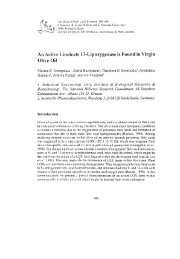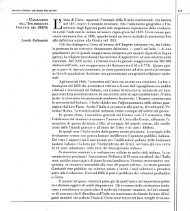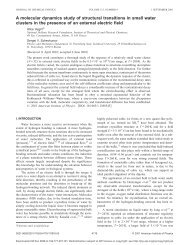Detection of human papilloma virus (HPV) and K-ras mutations in ...
Detection of human papilloma virus (HPV) and K-ras mutations in ...
Detection of human papilloma virus (HPV) and K-ras mutations in ...
You also want an ePaper? Increase the reach of your titles
YUMPU automatically turns print PDFs into web optimized ePapers that Google loves.
INTERNATIONAL JOURNAL OF ONCOLOGY 8: 1089-1093, 1996<br />
<strong>Detection</strong> <strong>of</strong> <strong>human</strong> <strong>papilloma</strong> <strong>virus</strong> (<strong>HPV</strong>) <strong>and</strong> K-<strong>ras</strong><br />
<strong>mutations</strong> <strong>in</strong> <strong>human</strong> lung carc<strong>in</strong>omas<br />
A. NOUTSOU 1·2<br />
, M. KOFFA 1·3<br />
, M. ERGAZAKI 1·3<br />
, N.M. SIAFAKAS 1 <strong>and</strong> DA. SPANDIDOS 1·3<br />
Medical School, University <strong>of</strong> Crete, Heraklion; department <strong>of</strong> Pathology, 'Sismanoglion' General Hospital, Athens;<br />
Institute <strong>of</strong> Biological Research <strong>and</strong> Biotechnology, National Hellenic Research Foundation, Athens, Greece<br />
Contributed by D.A. Sp<strong>and</strong>idos, April 2, 1996<br />
Abstract. The purpose <strong>of</strong> our study was to assess the<br />
prevalence <strong>and</strong> prognostic significance <strong>of</strong> <strong>HPV</strong> <strong>in</strong>fection as<br />
well as K-<strong>ras</strong> codon 12 po<strong>in</strong>t <strong>mutations</strong> <strong>in</strong> lung cancer.<br />
Patients diagnosed with lung carc<strong>in</strong>oma between 1988 <strong>and</strong><br />
1992 (N=99) were selected. <strong>HPV</strong> detection <strong>and</strong> typ<strong>in</strong>g was<br />
performed by PCR from paraff<strong>in</strong>-embedded tissues, while<br />
<strong>mutations</strong> <strong>in</strong> codon 12 <strong>of</strong> K-<strong>ras</strong> gene were detected us<strong>in</strong>g the<br />
restriction fragment length polymorphism (RFLP) analysis. The<br />
prevalence <strong>of</strong> <strong>HPV</strong> <strong>in</strong>fection was 15%, while K-<strong>ras</strong> codon 12<br />
po<strong>in</strong>t <strong>mutations</strong> were found <strong>in</strong> 18% <strong>of</strong> the specimens exam<strong>in</strong>ed.<br />
In 50% <strong>of</strong> the <strong>HPV</strong>-positive cases, K-<strong>ras</strong> gene mutation coexisted.<br />
<strong>HPV</strong> 18 was the most frequent type. No correlation<br />
was found between K-<strong>ras</strong> mutation <strong>and</strong> <strong>HPV</strong> <strong>in</strong>fection with<br />
sex, age <strong>and</strong> cl<strong>in</strong>ical outcome <strong>of</strong> the patient, or the histological<br />
type <strong>and</strong> the differentiation grade <strong>of</strong> the tumor. An association<br />
was found between K-<strong>ras</strong> codon 12 po<strong>in</strong>t <strong>mutations</strong> <strong>and</strong> the<br />
stage <strong>of</strong> the tumor, occurr<strong>in</strong>g more frequently at stage III<br />
(p=0.037). Infection with potentially oncogenic <strong>HPV</strong> types<br />
could co-operate with K-<strong>ras</strong> gene activation <strong>in</strong> the<br />
progression <strong>of</strong> the disease, s<strong>in</strong>ce K-<strong>ras</strong> activation by po<strong>in</strong>t<br />
<strong>mutations</strong> seems to be a late event <strong>in</strong> lung carc<strong>in</strong>ogenesis.<br />
Introduction<br />
Carc<strong>in</strong>oma <strong>of</strong> the lung has become <strong>in</strong>creas<strong>in</strong>gly frequent dur<strong>in</strong>g<br />
the past 50 years. It is now the lead<strong>in</strong>g cause <strong>of</strong> cancer mortality<br />
<strong>in</strong> the Western world. This is due not only to <strong>in</strong>creased<br />
recognition through better radiographic, bronchoscopic <strong>and</strong><br />
cytologic techniques but also to an actual rise <strong>in</strong> <strong>in</strong>cidence.<br />
Carc<strong>in</strong>oma <strong>of</strong> the lung is associated with various environmental<br />
factors, most importantly smok<strong>in</strong>g <strong>and</strong> asbestos exposure (1-3).<br />
However, many heavy smokers rema<strong>in</strong> free <strong>of</strong> this disease or<br />
other smok<strong>in</strong>g-related cancers. It has been suggested that<br />
genetic factors may also contribute to the development <strong>of</strong> lung<br />
carc<strong>in</strong>oma. So far, no classical l<strong>in</strong>kage analysis that correlates<br />
Correspondence to: Pr<strong>of</strong>essor D.A. Sp<strong>and</strong>idos, Medical School,<br />
University <strong>of</strong> Crete, Heraklion 71409, Greece<br />
Key words: <strong>human</strong> <strong>papilloma</strong> <strong>virus</strong> (<strong>HPV</strong>), K-<strong>ras</strong> oncogene, lung<br />
carc<strong>in</strong>oma<br />
<strong>in</strong>cidence <strong>of</strong> the disease with the <strong>in</strong>heritance <strong>of</strong> genetic markers,<br />
has been reported for lung cancer (4).<br />
Dur<strong>in</strong>g recent years, a great deal <strong>of</strong> data has been<br />
accumulated on the role <strong>of</strong> <strong>HPV</strong> <strong>in</strong> the development <strong>of</strong><br />
carc<strong>in</strong>oma <strong>of</strong> different anatomical sites <strong>of</strong> the body. Molecular<br />
biology techniques have disclosed that there are at least 73<br />
different types <strong>and</strong> several subtypes <strong>of</strong> <strong>HPV</strong> (5,6). Most viral<br />
types are observed <strong>in</strong> anogenital tract <strong>and</strong> sk<strong>in</strong> lesions (7).<br />
<strong>HPV</strong> has also been detected <strong>in</strong> carc<strong>in</strong>omas <strong>of</strong> the oral <strong>and</strong><br />
nasal cavity (8), the male urethra (9), the ur<strong>in</strong>ary bladder (ΙΟ<br />
Ι 2), the esophagus <strong>and</strong> the respiratory tract.<br />
With regard to the upper respiratory tract, many types <strong>of</strong><br />
<strong>HPV</strong> (6, 11,16, 30) have been detected <strong>in</strong> laryngeal carc<strong>in</strong>omas<br />
(13,14). Clear etiological evidence <strong>in</strong>dicated that <strong>in</strong> laryngeal<br />
<strong>papilloma</strong>s <strong>in</strong>fection with <strong>HPV</strong> types 16 <strong>and</strong> 18 was associated<br />
with progression to malignant lesions, whereas <strong>HPV</strong> types 6b<br />
<strong>and</strong> 11 were usually associated with benign lesions (15).<br />
In the lower respiratory tract, the causative role <strong>of</strong> <strong>HPV</strong> was<br />
suggested by morphological data already <strong>in</strong> 1979: cytological<br />
<strong>and</strong> histological similarities with lesions from uter<strong>in</strong>e cervix<br />
condylomas were described <strong>in</strong> about 30% <strong>of</strong> bronchial<br />
epithelium next to <strong>in</strong>vasive bronchial squamous cell carc<strong>in</strong>oma<br />
(16) or well differentiated squamous cell carc<strong>in</strong>oma (17,18).<br />
<strong>HPV</strong> sequences have also been demonstrated <strong>in</strong> primary lung<br />
squamous cell carc<strong>in</strong>omas (19-21). Patients with squamous<br />
cell <strong>papilloma</strong>s exhibit<strong>in</strong>g <strong>HPV</strong> 16 or 18 positivity are at high<br />
risk for the development <strong>of</strong> squamous cell carc<strong>in</strong>oma. Virus<br />
typ<strong>in</strong>g seems to be a better prognostic <strong>in</strong>dicator than grad<strong>in</strong>g <strong>of</strong><br />
dysplasia or age relationship, while <strong>virus</strong> typ<strong>in</strong>g by the PCR is<br />
more sensitive compared with <strong>in</strong> situ hybridization (ISH) (22).<br />
Moreover, molecular tumor markers may <strong>of</strong>fer cl<strong>in</strong>ically<br />
useful tools for diagnostic <strong>and</strong> prognostic purposes <strong>in</strong> lung<br />
cancer (23). Ras genes are <strong>of</strong>ten found activated <strong>in</strong> a variety <strong>of</strong><br />
tumor types, although the <strong>in</strong>cidence varies greatly. K-<strong>ras</strong> gene<br />
is by far the most frequently <strong>in</strong>volved <strong>in</strong> lung tumors (24-27).<br />
Po<strong>in</strong>t <strong>mutations</strong> <strong>of</strong> the K-<strong>ras</strong> gene were observed primarily <strong>in</strong><br />
patients with a habit <strong>of</strong> smok<strong>in</strong>g. Patients with K-<strong>ras</strong> positive<br />
tumors have a significantly poorer prognosis than patients with<br />
K-<strong>ras</strong> negative tumors (28). There is evidence that K-<strong>ras</strong> gene<br />
may serve as a genetic marker not only <strong>in</strong> the early detection<br />
<strong>of</strong> lung cancer (29) but also <strong>in</strong> the differential diagnosis <strong>of</strong><br />
recurrence or metastasis versus second primaries <strong>of</strong> the lung<br />
(30). In addition strong overexpression <strong>of</strong> K-<strong>ras</strong> gene has been<br />
reported <strong>in</strong> a high <strong>in</strong>cidence <strong>of</strong> non-small cell lung carc<strong>in</strong>omas<br />
(31).
1090 NOUTSOU et al: <strong>HPV</strong> AND K-<strong>ras</strong> IN LUNG CARCINOMA<br />
In the current study, <strong>HPV</strong> detection <strong>and</strong> typ<strong>in</strong>g as well as<br />
detection <strong>of</strong> K-<strong>ras</strong> gene <strong>mutations</strong> was performed <strong>in</strong> 99 cases<br />
<strong>of</strong> lung carc<strong>in</strong>oma from paraff<strong>in</strong>-embedded tissues employ<strong>in</strong>g<br />
the PCR technique. 15% <strong>of</strong> the specimens were found positive<br />
for <strong>HPV</strong>, while 18% carried mutation <strong>in</strong> the codon 12 <strong>of</strong> the<br />
K-<strong>ras</strong> gene. It was also exam<strong>in</strong>ed whether such alterations<br />
correlate with cl<strong>in</strong>icopathological parameters or cl<strong>in</strong>ical<br />
outcome.<br />
Materials <strong>and</strong> methods<br />
Patients <strong>and</strong> specimens. The primary neoplasm specimens<br />
were excised either by surgical lobectomy or pneumonectomy<br />
<strong>and</strong> fixed <strong>in</strong> neutral formal<strong>in</strong>, at Sismanoglion General Hospital,<br />
Athens, between 1988-1992. Hematoxyl<strong>in</strong>-eos<strong>in</strong> sta<strong>in</strong>ed sections<br />
from all paraff<strong>in</strong>-embedded tissues exam<strong>in</strong>ed, were reviewed<br />
to reconfirm the tumor type, differentiation grade while representative<br />
blocks (one per case) were selected for further<br />
analysis.<br />
Eighty-seven <strong>of</strong> the 99 patients were smokers, 3 were nonsmokers<br />
<strong>and</strong> for the rema<strong>in</strong><strong>in</strong>g 9 no reliable data on smok<strong>in</strong>g<br />
habits were available. Most <strong>of</strong> the smokers were heavy smokers<br />
(>60 py). The age range was 44-77 years, <strong>and</strong> the mean age<br />
62.8 years.<br />
DNA extraction. Five or six 10 μηι thick sections from formal<strong>in</strong>fixed,<br />
paraff<strong>in</strong>-embedded tissues were lysed <strong>in</strong> 400 μΐ digestion<br />
buffer, conta<strong>in</strong><strong>in</strong>g 100 mM NaCl, 10 mM Tris-HCl, 25 raM<br />
EDTA, 0.5% SDS pH 8.0, 0.1 mg/ml prote<strong>in</strong>ase K. Samples<br />
were <strong>in</strong>cubated for 24 h at 37°C. Fresh prote<strong>in</strong>ase Κ was added<br />
<strong>and</strong> the <strong>in</strong>cubation was cont<strong>in</strong>ued for another 24 h. The samples<br />
were then extracted once with phenol/chlor<strong>of</strong>orm <strong>and</strong> once<br />
with chlor<strong>of</strong>orm. DNA was precipitated with the addition <strong>of</strong><br />
20 μΐ 5 M NaCl <strong>and</strong> 1 ml ethanol, recovered by centrifugation<br />
for 15 m<strong>in</strong> at 4°C, washed once with cold 70% ethanol <strong>and</strong><br />
resuspended <strong>in</strong> 30 μΐ double distilled water.<br />
Oligonucleotide primers <strong>and</strong> PCR amplification. For the<br />
detection <strong>and</strong> type dist<strong>in</strong>ction <strong>of</strong> the <strong>HPV</strong>, multiplex PCR was<br />
employed us<strong>in</strong>g four pairs <strong>of</strong> primers stimultaneously (for <strong>HPV</strong><br />
types 11, 16, 18 <strong>and</strong> 33), provid<strong>in</strong>g different lengths <strong>of</strong> amplified<br />
DNA for each <strong>virus</strong> type (32), while the results were confirmed<br />
us<strong>in</strong>g the general primers GP5 <strong>and</strong> GP6 (33) followed by Rsal<br />
digestion giv<strong>in</strong>g a different pattern for each type (34). The<br />
oligonucleotides used for K-<strong>ras</strong> have been previously described<br />
(35). One μΐ <strong>of</strong> the extracted DNA <strong>of</strong> each sample was amplified<br />
<strong>in</strong> a reaction solution <strong>of</strong> 50 μΐ conta<strong>in</strong><strong>in</strong>g 20 mM (NH 4<br />
) 2<br />
S0 4<br />
,<br />
2.0 mM MgCl 2<br />
, 75 mM Tris-HCl pH 9.0, 0.01% (w/v) Tween,<br />
200 μΜ <strong>of</strong> each dNTP, 0.5 μΜ <strong>of</strong> each primer <strong>and</strong> 1.25 U Taq<br />
polyme<strong>ras</strong>e (Advanced Biotechnologies). The mixture was<br />
heated for 1 m<strong>in</strong> at 95°C, <strong>and</strong> then subjected to 35 cycles <strong>of</strong><br />
amplification under the follow<strong>in</strong>g conditions.<br />
<strong>HPV</strong> amplification: Us<strong>in</strong>g the specific set <strong>of</strong> primers each<br />
cycle consisted <strong>of</strong> 50 sec at 94 °C, 40 sec at 56°C <strong>and</strong> 45 sec at<br />
72°C, <strong>in</strong>creas<strong>in</strong>g the elongation time 1 sec per cycle. To<br />
establish type specificity <strong>of</strong> primer-directed amplification, each<br />
set <strong>of</strong> primers was tested with template plasmid DNA <strong>of</strong> the<br />
five <strong>HPV</strong> types 6b, 11, 16, 18 <strong>and</strong> 33.<br />
Us<strong>in</strong>g the general primers GP5 <strong>and</strong> GP6 each cycle<br />
consisted <strong>of</strong> 50 sec at 94°C, 50 sec at 52°C <strong>and</strong> 40 sec at 72°C,<br />
<strong>in</strong>creas<strong>in</strong>g the elongation time 1 sec per cycle.<br />
K-<strong>ras</strong> amplification: Each cycle consisted <strong>of</strong> a denaturation<br />
step at 94°C for 50 sec, an anneal<strong>in</strong>g step at 58°C for 45 sec<br />
<strong>and</strong> an elongation step at 72°C for 50 sec, <strong>in</strong>creas<strong>in</strong>g the<br />
elongation time 1 sec per cycle.<br />
RFLP analysis. <strong>HPV</strong>-general primers: Confirmation <strong>of</strong> the<br />
typ<strong>in</strong>g was achieved by digestion <strong>of</strong> the amplification products<br />
with 30 U <strong>of</strong> Rsal giv<strong>in</strong>g a different pattern for each type.<br />
Digestion products were electrophoresed through a 10%<br />
Polyacrylamide gel. As control the amplified product <strong>of</strong> plasmid<br />
DNA <strong>of</strong> the <strong>HPV</strong> types 6b, 11, 16, 18 <strong>and</strong> 33 were used.<br />
K-<strong>ras</strong>; 10-20 μΐ were digested for 3 h with 30 U <strong>of</strong> BstNI.<br />
Digestion products were electrophoresed through an 8%<br />
Polyacrylamide gel. Gels were sta<strong>in</strong>ed with ethidium bromide<br />
<strong>and</strong> photographed on a UV light transillum<strong>in</strong>ator. Enzymes<br />
were supplied by New Engl<strong>and</strong> Biolabs <strong>and</strong> the conditions<br />
followed for digestions were those recommended by the<br />
supplier. Incubation temperatures were 37°C for Rsal <strong>and</strong><br />
60°C for BstNI.<br />
Statistical analysis. The presence <strong>of</strong> <strong>HPV</strong> <strong>and</strong> <strong>mutations</strong> at<br />
codon 12 <strong>of</strong> K-<strong>ras</strong> gene were analysed for significant correlation<br />
with histological type, grade, TNM stage <strong>and</strong> age at day <strong>of</strong><br />
operation, by Fisher's exact test. Survival curves were drawn up<br />
us<strong>in</strong>g the Kaplan-Meier method. Differences between survival<br />
times were analysed by the log rank method.<br />
Results<br />
In the current study we exam<strong>in</strong>ed 99 specimens from patients<br />
with lung carc<strong>in</strong>omas. Tumors were classified accord<strong>in</strong>g to their<br />
histological type: 41 adenocarc<strong>in</strong>omas, 41 squamous cell, 10<br />
undifferentiated large cell, 5 small cell <strong>and</strong> 2 adenosquamous<br />
carc<strong>in</strong>omas. Accord<strong>in</strong>g to the degree <strong>of</strong> histological<br />
differentiation: 7 well, 42 moderate <strong>and</strong> 33 poorly differentiated<br />
carc<strong>in</strong>omas. Tumors were also staged accord<strong>in</strong>g to the TNM<br />
system as: 46 <strong>in</strong> stage I, 37 <strong>in</strong> stage II <strong>and</strong> 16 <strong>in</strong> stage III.<br />
Follow-up was available for 42 patients. 32 have died <strong>of</strong> the<br />
disease while 10 patients are still alive (after 1-63 months<br />
follow<strong>in</strong>g surgery). Although no statistically significant<br />
correlations were found, the survival was shorter <strong>in</strong> patients<br />
with <strong>ras</strong> <strong>mutations</strong> (average survival 665.1 days), <strong>HPV</strong> <strong>in</strong>fection<br />
(a.s. 718.2 days) <strong>and</strong> <strong>HPV</strong> <strong>in</strong>fection simultaneously with <strong>ras</strong><br />
<strong>mutations</strong> (a.s. 773.1 days), compared to those with no such<br />
alterations (a.s. 929.7, 956.7 <strong>and</strong> 871.2 days respectively).<br />
The type <strong>of</strong> <strong>HPV</strong> as well as the presence <strong>of</strong> po<strong>in</strong>t <strong>mutations</strong><br />
<strong>in</strong> codon 12 <strong>of</strong> the K-<strong>ras</strong> gene were exam<strong>in</strong>ed. The results <strong>of</strong><br />
the PCR analysis are summarized <strong>in</strong> Table I.<br />
Fifteen <strong>of</strong> the 99 specimens (15%) were found positive for<br />
<strong>HPV</strong>. The prevalence <strong>of</strong> <strong>HPV</strong> <strong>in</strong>fection was 20% <strong>in</strong> adenocarc<strong>in</strong>omas,<br />
9.7% <strong>in</strong> squamous cell carc<strong>in</strong>omas, 20% <strong>in</strong> undifferentiated<br />
large cell carc<strong>in</strong>omas, while <strong>HPV</strong> was also<br />
found <strong>in</strong> one <strong>of</strong> the two adenosquamous carc<strong>in</strong>omas. Results<br />
from the type dist<strong>in</strong>ction <strong>of</strong> <strong>HPV</strong> (Fig. 1) <strong>in</strong>dicated that<br />
<strong>HPV</strong> 18 was the most frequent type (<strong>in</strong> 8% <strong>of</strong> the cases),<br />
while <strong>HPV</strong> 16 was found <strong>in</strong> 4%, <strong>HPV</strong> 11 <strong>in</strong> 3% <strong>and</strong> <strong>HPV</strong> 33 <strong>in</strong><br />
2% <strong>of</strong> the cases exam<strong>in</strong>ed (Table II). Samples found positive<br />
with the multiplex PCR (amplify<strong>in</strong>g a region from the E6<br />
ORF) were also positive with the general primer PCR,<br />
<strong>in</strong>dicat<strong>in</strong>g that the LI region was present.
INTERNATIONAL JOURNAL OF ONCOLOGY 8: 1089-1093, 1996 1091<br />
Table I. <strong>Detection</strong> <strong>of</strong> <strong>HPV</strong> <strong>and</strong> K-<strong>ras</strong> codon 12 po<strong>in</strong>t <strong>mutations</strong> <strong>in</strong> lung carc<strong>in</strong>omas by PCR.<br />
Histological<br />
type<br />
No. <strong>of</strong><br />
patients<br />
<strong>HPV</strong><br />
positive (%)<br />
K-<strong>ras</strong><br />
<strong>mutations</strong> (%)<br />
<strong>HPV</strong>+K-<strong>ras</strong><br />
(%)<br />
Adenocarc<strong>in</strong>oma<br />
41<br />
8 (20)<br />
8 (20)<br />
4 (9.8)<br />
Squamous cell carc<strong>in</strong>oma<br />
Undifferentiated large cell carc<strong>in</strong>oma<br />
Small cell carc<strong>in</strong>oma<br />
Adenosquamous carc<strong>in</strong>oma<br />
41<br />
to<br />
5<br />
2<br />
4 (9.8)<br />
2 (20)<br />
0<br />
1<br />
7 (17)<br />
2 (20)<br />
0<br />
1<br />
3 (7.3)<br />
1 (10)<br />
0<br />
1<br />
Total<br />
99<br />
15 (15)<br />
18 (18)<br />
9 (9.1)<br />
M 1 2 3 4 5 6 7 8 9 10 11 12 M<br />
bp<br />
315<strong>HPV</strong>-16<br />
236<strong>HPV</strong>-11<br />
171 <strong>HPV</strong>-33<br />
143 <strong>HPV</strong>-18<br />
157<br />
142 (mt)<br />
113 (wt)<br />
Figure l. Type dist<strong>in</strong>ction <strong>of</strong> <strong>HPV</strong> employ<strong>in</strong>g a multiplex PCR. Products <strong>of</strong><br />
different size (315 bp, <strong>HPV</strong> 16; 236 bp, <strong>HPV</strong> 11; 171 bp, <strong>HPV</strong>33; <strong>and</strong> 143 bp,<br />
<strong>HPV</strong> 18) were analysed by agarose gel electrophoresis. Lane M, molecular<br />
weight marker pUC18/HaeIII; lane 1, sample positive for <strong>HPV</strong> 11; lanes<br />
2,6, samples positive for <strong>HPV</strong> 18; lanes 3,7, samples positive for <strong>HPV</strong> 16;<br />
lane 4, sample positive for <strong>HPV</strong> 33; lane 5, sample positive for <strong>HPV</strong> 16-<br />
<strong>HPV</strong> 11.<br />
Figure 2. K-<strong>ras</strong> amplification products (157 bp) were digested with the<br />
restriction endonuclease BstNI <strong>and</strong> electrophoresed through an 8%<br />
Polyacrylamide gel. Lanes M, molecular weight marker pUCl8/HaeIII;<br />
lanes 1,11, positive control SW480 cell l<strong>in</strong>e (142 bp); lanes 2,12, undigested<br />
PCR product; lane 3, negative control; lanes 4,7-9, positive samples; lanes<br />
5,6,10, negative samples (113 bp).<br />
Table II. Incidence <strong>of</strong> <strong>HPV</strong> type <strong>in</strong> primary lung carc<strong>in</strong>omas.<br />
Type <strong>of</strong> <strong>HPV</strong><br />
<strong>HPV</strong> 18<br />
<strong>HPV</strong> 16<br />
<strong>HPV</strong> 11<br />
<strong>HPV</strong> 33<br />
a <strong>in</strong> a total <strong>of</strong> 99 samples.<br />
<strong>HPV</strong> positive carc<strong>in</strong>omas"<br />
K-<strong>ras</strong> codon 12 po<strong>in</strong>t <strong>mutations</strong> were found <strong>in</strong> 18 <strong>of</strong> the<br />
99 specimens (18%) exam<strong>in</strong>ed (Fig. 2). Mutations were found<br />
<strong>in</strong> 8 (20%) <strong>of</strong> the 41 cases <strong>of</strong> adenocarc<strong>in</strong>oma, <strong>in</strong> 7 (17%) <strong>of</strong><br />
the 41 cases <strong>of</strong> squamous cell carc<strong>in</strong>oma, <strong>in</strong> 2 (20%) <strong>of</strong> the<br />
10 cases <strong>of</strong> undifferentiated large cell carc<strong>in</strong>oma <strong>and</strong> <strong>in</strong> 1 <strong>of</strong><br />
the 2 cases <strong>of</strong> adenosquamous carc<strong>in</strong>oma.<br />
The simultaneous presence <strong>of</strong> <strong>HPV</strong> DNA <strong>and</strong> K-<strong>ras</strong><br />
mutation was observed <strong>in</strong> almost 50% <strong>of</strong> the <strong>HPV</strong> positive<br />
cases: <strong>in</strong> 9.8% <strong>of</strong> adenocarc<strong>in</strong>omas, <strong>in</strong> 7.3% <strong>of</strong> squamous cell<br />
carc<strong>in</strong>omas, <strong>in</strong> 10% <strong>of</strong> undifferentiated large cell carc<strong>in</strong>omas<br />
<strong>and</strong> <strong>in</strong> one <strong>of</strong> the two adenosquamous carc<strong>in</strong>omas.<br />
No correlation was found between <strong>HPV</strong> <strong>in</strong>fection <strong>and</strong> K-<strong>ras</strong><br />
mutation either with sex <strong>and</strong> age <strong>of</strong> the patient, or the histological<br />
type <strong>and</strong> the differentiation grade <strong>of</strong> the tumor. Survival curves<br />
4<br />
3<br />
2<br />
determ<strong>in</strong>ed by Kaplan-Meier method demonstrated that <strong>HPV</strong><br />
<strong>in</strong>fection <strong>and</strong> codon 12 po<strong>in</strong>t mutation <strong>of</strong> K-<strong>ras</strong> gene did not<br />
correlate with the cl<strong>in</strong>ical outcome <strong>of</strong> the patients. An association<br />
was found between K-<strong>ras</strong> codon 12 po<strong>in</strong>t <strong>mutations</strong> <strong>and</strong> the<br />
stage <strong>of</strong> the tumor, occur<strong>in</strong>g more frequently at stage III<br />
(p=0.037) than stage I. These data suggest that <strong>in</strong>fection with<br />
potentially oncogenic <strong>HPV</strong> types could be associated not only<br />
with anogenital tumors, but also with a subset <strong>of</strong> lung tumours,<br />
while <strong>HPV</strong> could co-operate with K-<strong>ras</strong> <strong>mutations</strong> <strong>in</strong> the<br />
progression <strong>of</strong> the disease.<br />
Discussion<br />
The potential role <strong>of</strong> <strong>HPV</strong> <strong>in</strong> the development <strong>of</strong> lung<br />
carc<strong>in</strong>omas emerged after the description <strong>of</strong> condylomatouslike<br />
lesions <strong>in</strong> the bronchial epithelium adjacent to squamous<br />
cell carc<strong>in</strong>omas. Intranuclear <strong>HPV</strong>-like particles were<br />
demonstrated by electron microscopy <strong>in</strong> squamous cell<br />
<strong>papilloma</strong>s <strong>of</strong> the bronchus (36).<br />
The presence <strong>of</strong> <strong>HPV</strong> <strong>in</strong> lung carc<strong>in</strong>omas has been reported<br />
<strong>in</strong> several studies. The rate <strong>of</strong> positivity varied between 4.2%<br />
<strong>and</strong> 31% (19-21), while <strong>in</strong> carc<strong>in</strong>omas with condylomatous<br />
changes the rate was higher (42%) (20). In cont<strong>ras</strong>t other<br />
<strong>in</strong>vestigators reported absence <strong>of</strong> <strong>HPV</strong> <strong>in</strong> lung cancer (37,38),<br />
this divergence may be due to the differences <strong>in</strong> the sensitivity<br />
<strong>and</strong> specificity <strong>of</strong> the methods applied, as well as to epidemio-
1092 NOUTSOU et al: <strong>HPV</strong> AND K-<strong>ras</strong> IN LUNG CARCINOMA<br />
logical factors. In the current study we confirm the presence<br />
<strong>of</strong> <strong>HPV</strong> <strong>in</strong> lung carc<strong>in</strong>omas, us<strong>in</strong>g primers from both the E6 <strong>and</strong><br />
LI ORFs. The use <strong>of</strong> primers located <strong>in</strong> the E6 ORF, which<br />
rema<strong>in</strong>s <strong>in</strong>tact <strong>in</strong> the case <strong>of</strong> high risk <strong>HPV</strong> type <strong>in</strong>tegration<br />
<strong>in</strong>to the host genome, allows better diagnostic sensitivity. No<br />
difference was found <strong>in</strong> the detection rate <strong>of</strong> the <strong>virus</strong> us<strong>in</strong>g<br />
the two sets <strong>of</strong> primers from the E6 <strong>and</strong> LI ORFs.<br />
It is noteworthy that <strong>HPV</strong> was also detected <strong>in</strong> cases <strong>of</strong><br />
adenocarc<strong>in</strong>oma. Recently, there has been <strong>in</strong>creas<strong>in</strong>g <strong>in</strong>terest<br />
<strong>in</strong> the association between <strong>HPV</strong> <strong>and</strong> gl<strong>and</strong>ular neoplasia. In<br />
many studies <strong>HPV</strong> DNA has been found <strong>in</strong> adenocarc<strong>in</strong>omas<br />
<strong>and</strong> adenosquamous carc<strong>in</strong>omas as frequently as <strong>in</strong> squamous<br />
cell carc<strong>in</strong>omas <strong>of</strong> the cervix (39-41).<br />
In our study we found that multiple subtypes <strong>of</strong> <strong>HPV</strong> may be<br />
related to lung cancer. However <strong>HPV</strong> 18 was the predom<strong>in</strong>ant<br />
type, which is <strong>in</strong> agreement with other studies report<strong>in</strong>g that<br />
high-risk <strong>HPV</strong> types were more frequently detected (19,20,22).<br />
Their identification <strong>in</strong> both squamous cell carc<strong>in</strong>omas <strong>and</strong><br />
adenocarc<strong>in</strong>omas as well as <strong>in</strong> adenosquamous <strong>and</strong> undifferentiated<br />
large cell carc<strong>in</strong>omas suggests a key role <strong>in</strong> the<br />
process <strong>of</strong> lung carc<strong>in</strong>ogenesis. Moreover, it has been suggested<br />
that <strong>in</strong>fection with high risk <strong>HPV</strong>s could serve as a prognostic<br />
<strong>in</strong>dicator <strong>of</strong> malignant progression <strong>in</strong> lung squamous cell<br />
<strong>papilloma</strong>s (22).<br />
Multiple molecular changes have also been documented<br />
<strong>in</strong> lung cancer. These <strong>in</strong>clude activation <strong>of</strong> dom<strong>in</strong>ant oncogenes,<br />
such as the <strong>ras</strong> gene family (23), myc <strong>and</strong> HER-2/new<br />
genes, as well as loss <strong>of</strong> recessive growth regulatory genes,<br />
or onco-suppressor genes (p53, rb) (23,26).<br />
Several studies have reported an <strong>in</strong>cidence <strong>of</strong> 15-33% <strong>of</strong><br />
activated K-<strong>ras</strong> gene <strong>in</strong> lung carc<strong>in</strong>omas, while more recent<br />
studies have revealed a higher <strong>in</strong>cidence <strong>of</strong> more than 50%<br />
(42-44). In the current study we found K-<strong>ras</strong> codon 12 po<strong>in</strong>t<br />
<strong>mutations</strong> <strong>in</strong> 18% <strong>of</strong> the specimens exam<strong>in</strong>ed. In cases <strong>of</strong><br />
squamous cell carc<strong>in</strong>omas the <strong>in</strong>cidence <strong>of</strong> K-<strong>ras</strong> <strong>mutations</strong><br />
was higher than <strong>in</strong> other studies (24,42), propably due to the<br />
more sensitive assay used. Activation <strong>of</strong> the K-<strong>ras</strong> gene was<br />
exam<strong>in</strong>ed, s<strong>in</strong>ce po<strong>in</strong>t <strong>mutations</strong> <strong>of</strong> this member <strong>of</strong> the <strong>ras</strong><br />
family are found more commonly <strong>in</strong> lung cancer <strong>and</strong> occur<br />
predom<strong>in</strong>antly at codon 12.<br />
It has been suggested that K-<strong>ras</strong> <strong>mutations</strong> arise predom<strong>in</strong>antly<br />
at the non-<strong>in</strong>vasive stage <strong>of</strong> lung carc<strong>in</strong>ogenesis,<br />
<strong>and</strong> may be associated with the transformation <strong>of</strong> dysplastic<br />
cells to neoplastic (45). Moreover, detection <strong>of</strong> K-<strong>ras</strong> <strong>mutations</strong><br />
<strong>in</strong> sputum may precede diagnosis <strong>of</strong> lung cancer (29). On the<br />
other h<strong>and</strong>, a significant number <strong>of</strong> lung adenocarc<strong>in</strong>omas<br />
harbor <strong>ras</strong> <strong>mutations</strong> <strong>in</strong> only a small percentage <strong>of</strong> the cancer<br />
cells, <strong>in</strong>dicat<strong>in</strong>g that K-<strong>ras</strong> <strong>mutations</strong> represent a late event <strong>in</strong><br />
lung carc<strong>in</strong>ogenesis (23). This concept is consistent with the<br />
association <strong>of</strong> <strong>ras</strong> <strong>mutations</strong> with <strong>in</strong>creased tumor growth <strong>and</strong><br />
<strong>in</strong>vasiveness, as suggested by the poorer prognosis <strong>of</strong> mutationpositive<br />
than mutation-negative cases treated by surgical<br />
resection (44,46). We found an association between K-<strong>ras</strong><br />
<strong>mutations</strong> <strong>and</strong> the stage <strong>of</strong> the tumor, occur<strong>in</strong>g more frequently<br />
at cases with stage III. However, no correlation was found<br />
between K-<strong>ras</strong> <strong>mutations</strong> <strong>and</strong> the cl<strong>in</strong>ical outcome <strong>of</strong> the<br />
patients exam<strong>in</strong>ed. In 50% <strong>of</strong> the <strong>HPV</strong>-positive cases, K-<strong>ras</strong><br />
mutation co-existed. This might suggest that <strong>HPV</strong> <strong>in</strong>fection<br />
is not sufficient by itself for malignant transformation, but<br />
requires co-operation <strong>of</strong> an activated <strong>ras</strong> gene. In addition,<br />
carc<strong>in</strong>ogen exposure may <strong>in</strong>duce transformation <strong>in</strong> several<br />
fields <strong>of</strong> the bronchial epithelium through the <strong>in</strong>duction <strong>of</strong><br />
different genetic changes.<br />
Our results <strong>in</strong>dicate that <strong>HPV</strong> <strong>in</strong>fection <strong>and</strong> K-<strong>ras</strong> gene<br />
activation may play a role <strong>in</strong> a subset <strong>of</strong> lung tumors. The<br />
possibility <strong>of</strong> synergic mechanisms between <strong>HPV</strong>, <strong>ras</strong> gene<br />
<strong>mutations</strong> <strong>and</strong> chemical or physical carc<strong>in</strong>ogens such as cigarette<br />
smok<strong>in</strong>g should also be considered.<br />
References<br />
1. Loeb LA, Ernster VL, Warner KE, Abbotts J <strong>and</strong> Laszio J:<br />
Smok<strong>in</strong>g <strong>and</strong> lung cancer: an overview. Cancer Res 44: 5940-5958,<br />
1984.<br />
2. Kvale G, Bjelke E <strong>and</strong> Heuch I: Occupational exposure <strong>and</strong><br />
lung cancer risk. Int J Cancer 37: 185-193, 1986.<br />
3. Selik<strong>of</strong>f 1J, Hammond EC <strong>and</strong> Chyrg J: Asbestos exposure,<br />
smok<strong>in</strong>g <strong>and</strong> neoplasia. JAMA 204: 106-112, 1968.<br />
4. Rabbitts PH: Genetic changes <strong>in</strong> the development <strong>of</strong> lung<br />
cancer. Br Med Bull 50: 688-697, 1994.<br />
5. zur Hausen H <strong>and</strong> de Villiers EM: Human <strong>papilloma</strong><strong>virus</strong>es.<br />
Annu Rev Microbiol 48: 427-447, 1994.<br />
6. Vousden KH: Viruses <strong>and</strong> <strong>human</strong> cancer. Br Med Bull 50:<br />
560-581, 1994.<br />
7. zur Hausen H: Human <strong>papilloma</strong><strong>virus</strong> <strong>in</strong> the pathogenesis <strong>of</strong><br />
anogenital cancer. Virology 184: 9-13, 1991.<br />
8. Furuta Y, Takasu T, Asai T, Sh<strong>in</strong>ohara T, Sawa H, Nagashima Κ<br />
<strong>and</strong> Inuyama Y: <strong>Detection</strong> <strong>of</strong> <strong>human</strong> <strong>papilloma</strong><strong>virus</strong> DNA <strong>in</strong><br />
carc<strong>in</strong>omas <strong>of</strong> the nasal cavities <strong>and</strong> paranasal s<strong>in</strong>uses by<br />
polyme<strong>ras</strong>e cha<strong>in</strong> reaction. Cancer 69: 353-357, 1992.<br />
9. Wiener JS, Liu ET <strong>and</strong> Walther PJ: Oncogenic <strong>human</strong> <strong>papilloma</strong><strong>virus</strong><br />
type 16 is associated with squamous cell cancer <strong>of</strong> the<br />
male urethra. Cancer Res 52: 5018-5023, 1992.<br />
10. Anwar K, Naiki H, Nakakuki Κ <strong>and</strong> Inzuzuka M: High frequency<br />
<strong>of</strong> <strong>human</strong> <strong>papilloma</strong><strong>virus</strong> <strong>in</strong>fection <strong>in</strong> carc<strong>in</strong>oma <strong>of</strong> the ur<strong>in</strong>ary<br />
bladder. Cancer 70: 1967-1973, 1992.<br />
11. Noel JC, Thiry L, Verhest A, Deschepper N, Peny MO, Sattar AA,<br />
Schulman CC <strong>and</strong> Haot J: Transitional cell carc<strong>in</strong>oma <strong>of</strong> the<br />
bladder evaluation <strong>of</strong> the role <strong>of</strong> <strong>human</strong> <strong>papilloma</strong><strong>virus</strong>es. Urology<br />
44:671-675, 1994.<br />
12. Maloney K, Wiener Η <strong>and</strong> Walter PH: Oncogenic <strong>human</strong><br />
<strong>papilloma</strong><strong>virus</strong>es are rarely associated with squamous cell<br />
carc<strong>in</strong>oma <strong>of</strong> the bladder: evaluation by differential polyme<strong>ras</strong>e<br />
cha<strong>in</strong> reaction. J Urol 154: 360-364, 1994.<br />
13. Hoshikawa T, Nakajima T, Uhara H, Gotoh M, Shimosato Y,<br />
Tsutsumi K, Ono I <strong>and</strong> Ebihara S: <strong>Detection</strong> <strong>of</strong> <strong>human</strong> <strong>papilloma</strong><strong>virus</strong><br />
DNA <strong>in</strong> laryngeal squamous cell carc<strong>in</strong>omas by polyme<strong>ras</strong>e<br />
cha<strong>in</strong> reaction. Laryngoscope 100: 647-650, 1990.<br />
14. Perez-Ayala M, Ruiz-Cabello F, Esteban F, Concha A, Redondo M,<br />
Oliva MR, Cabrera Τ <strong>and</strong> Garrido F: Presence <strong>of</strong> <strong>HPV</strong> 16<br />
sequences <strong>in</strong> laryngeal carc<strong>in</strong>omas. Int J Pathol 46: 8-11, 1990.<br />
15. McCance DJ: News on <strong>papilloma</strong><strong>virus</strong>es. Nature 335: 765-766,<br />
1988.<br />
16. Syrjänen KJ: Condylomatous changes <strong>in</strong> neoplastic bronchial<br />
epithelium: report <strong>of</strong> a case. Respiration 98: 299-304, 1979.<br />
17. Syrjänen KJ: Bronchial squamous cell carc<strong>in</strong>omas associated<br />
with epithelial changes identical to condylomatous lesions <strong>of</strong><br />
uter<strong>in</strong>e cervix. Lung 158: 131-142, 1980.<br />
18. Syrjänen KJ: Epithelial lesions suggestive <strong>of</strong> a condylomatous<br />
orig<strong>in</strong> found closely associated with <strong>in</strong>vasive bronchial squamous<br />
cell carc<strong>in</strong>omas. Respiration 40: 150-160, 1980.<br />
19. Yousem SA, Ohori NP <strong>and</strong> Sonmez-Alpan'E: Occurence <strong>of</strong><br />
<strong>human</strong> <strong>papilloma</strong><strong>virus</strong> DNA <strong>in</strong> primary lung neoplasms. Cancer<br />
69: 693-697, 1992.<br />
20. Bejui-Thivolet F, Liagre N, Chignol M, Chardonnet Y <strong>and</strong><br />
Patricot L: <strong>Detection</strong> <strong>of</strong> <strong>human</strong> <strong>papilloma</strong><strong>virus</strong> DNA <strong>in</strong> squamous<br />
bronchial metaplasia <strong>of</strong> the lung by <strong>in</strong> situ hybridization us<strong>in</strong>g<br />
biot<strong>in</strong>ylated probes <strong>in</strong> paraff<strong>in</strong>-embedded specimens. Hum<br />
Pathol 21: 111-116, 1990.<br />
21. Bejui-Thivolet F, Chardonnet Y <strong>and</strong> Patricot L: Human <strong>papilloma</strong><strong>virus</strong><br />
type 11 DNA <strong>in</strong> papillary squamous cell lung carc<strong>in</strong>oma.<br />
Virchows Arch (A) 417: 457-461, 1990.<br />
22. Popper HH, El-Shabrawi Y, Wöckel W, Höfler G, Kenner L,<br />
Freya, Juttner-Smole <strong>and</strong> Pongratz MG: Prognostic importance<br />
<strong>of</strong> <strong>human</strong> <strong>papilloma</strong><strong>virus</strong> typ<strong>in</strong>g <strong>in</strong> squamous cell carc<strong>in</strong>oma <strong>of</strong><br />
the bronchus. Hum Pathol 25: 1191-1197, 1994.
INTERNATIONAL JOURNAL OF ONCOLOGY 8: 1089-1093, 1996 1093<br />
23. Anderson MLM <strong>and</strong> Sp<strong>and</strong>idos DA: Oncogenes <strong>and</strong> oncosuppressor<br />
genes <strong>in</strong> lung cancer. Rcsp Med 87: 413-420, 1993.<br />
24. Kiaris H <strong>and</strong> Sp<strong>and</strong>idos DA: Mutations <strong>of</strong> <strong>ras</strong> genes <strong>in</strong> <strong>human</strong><br />
tumours (review). Int J Oncol 7: 413-421, 1995.<br />
25. Neville EM, Ellison G, Kiaris H, Stewart M, Sp<strong>and</strong>idos DA <strong>and</strong><br />
Field JK: <strong>Detection</strong> <strong>of</strong> K-<strong>ras</strong> <strong>mutations</strong> <strong>in</strong> non-small cell lung<br />
carc<strong>in</strong>oma. Int J Oncol 7: 511-514, 1995.<br />
26. Kiaris H, Ergazaki M, Sakkas S, Athanasiadou E <strong>and</strong><br />
Sp<strong>and</strong>idos DA: <strong>Detection</strong> <strong>of</strong> activat<strong>in</strong>g <strong>mutations</strong> <strong>in</strong> the <strong>ras</strong> family<br />
gene <strong>in</strong> cytological specimens from lung tumours. Oncol Rep 2:<br />
769-772, 1995.<br />
27. Mills NE, Fishman CL, Rom WN, Dub<strong>in</strong> Ν <strong>and</strong> Jacobson DR:<br />
Increased prevalence <strong>of</strong> K-<strong>ras</strong> oncogene <strong>mutations</strong> <strong>in</strong> lung adenocarc<strong>in</strong>oma.<br />
Cancer Res 55: 1444-1447, 1995.<br />
28. Slebos RJ, Kibbelaar RE, Dalesio O, Kooistra A, Stam J,<br />
Mcijer CJ, Wagenaar SS, V<strong>and</strong>erschueren RG, van Z<strong>and</strong>ijk N,<br />
Mooi WJ, Bos JL <strong>and</strong> Rodenhuis S: K-rai oncogene activation<br />
as a prognostic marker <strong>in</strong> adenocarc<strong>in</strong>oma <strong>of</strong> the lung. Ν Engl J<br />
Med 323: 561-565, 1990.<br />
29. Mao L, Hruban H, Boyle JO, Tockman M <strong>and</strong> Sidransky D:<br />
<strong>Detection</strong> <strong>of</strong> oncogene <strong>mutations</strong> <strong>in</strong> sputum precedes diagnosis<br />
<strong>in</strong> lung cancer. Cancer Res 54: 1634-1637, 1994.<br />
30. Sozzi G, Miozzo M, Pastor<strong>in</strong>o U, Pilotti S, Donghi R, Giarda M,<br />
De-Gregorio L, Manenti G, Radice Ρ, M<strong>in</strong>oletti F, Della Porta G<br />
<strong>and</strong> Pierotli MA: Genetic evidence for an <strong>in</strong>dependent orig<strong>in</strong> <strong>of</strong><br />
multiple preneoplastic <strong>and</strong> neoplastic lung lesions. Cancer Res<br />
55: 135-140, 1995.<br />
31. Lorenz J, Friedberg Τ, Oesch F <strong>and</strong> Ferl<strong>in</strong>z R: Oncogene overexpression<br />
<strong>in</strong> non-small cell lung cancer tissue: prevalence <strong>and</strong><br />
cl<strong>in</strong>icopathological significance. Cl<strong>in</strong> Investigator 72: 156-163,<br />
1994.<br />
32. Arends MJ, Donaldson YK, Duvall E, Wyllie AH <strong>and</strong> Bird CC:<br />
<strong>HPV</strong> <strong>in</strong> full thickness cervical biopsies: high prevalence <strong>in</strong><br />
CIN 2 <strong>and</strong> CIN 3 detected by a sensitive PCR method. J Pathol<br />
165:301-309, 1991.<br />
33. Snijders PJF, van den Brule AJC, Schrijnemakers HFJ, Snow G,<br />
Meijer CJLM <strong>and</strong> Walboomers JMM: The use <strong>of</strong> general primers<br />
<strong>in</strong> the polyme<strong>ras</strong>e cha<strong>in</strong> reaction permits the detection <strong>of</strong> a<br />
broad spectrum <strong>of</strong> <strong>human</strong> <strong>papilloma</strong><strong>virus</strong> genotypes. J Gen<br />
Virol 71: 173-181, 1990.<br />
34. K<strong>of</strong>fa M, Koumantakis E, Ergazaki M, Malamou-Mitsi V <strong>and</strong><br />
Sp<strong>and</strong>idos DA: <strong>Detection</strong> <strong>of</strong> <strong>ras</strong> gene <strong>mutations</strong> <strong>and</strong> <strong>HPV</strong> <strong>in</strong><br />
lesions <strong>of</strong> the <strong>human</strong> female reproductive tract. Int J Oncol 5:<br />
189-195, 1994.<br />
35. Sp<strong>and</strong>idos DA, Liloglou T, Arvanitis D <strong>and</strong> Gourtsoyiannis NC:<br />
Ras gene activation <strong>in</strong> <strong>human</strong> small <strong>in</strong>test<strong>in</strong>al tumors. Int J<br />
Oncol 2: 513-518, 1993.<br />
36. Br<strong>and</strong>we<strong>in</strong> M, Ste<strong>in</strong>berg Β, Thung S, et al: Human <strong>papilloma</strong><strong>virus</strong><br />
6/11 <strong>and</strong> 16/18 <strong>in</strong> Schnciderian <strong>in</strong>verted <strong>papilloma</strong>s. In<br />
situ hybridization with <strong>human</strong> <strong>papilloma</strong><strong>virus</strong> RNA probes.<br />
Cancer 63: 1708-1713, 1989.<br />
37. Szabo I, Sepp R, Nakamoto K, Maeda M, Sakamoto H <strong>and</strong> Uda H:<br />
Human <strong>papilloma</strong><strong>virus</strong> not found <strong>in</strong> squamous <strong>and</strong> large cell lung<br />
carc<strong>in</strong>omas by polyme<strong>ras</strong>e cha<strong>in</strong> reaction. Cancer 73: 2740-2744,<br />
1994.<br />
38. Shaman<strong>in</strong> V, Delius H <strong>and</strong> de Villiers EM: Development <strong>of</strong> a<br />
broad spectrum PCR assay for <strong>papilloma</strong> <strong>virus</strong>es <strong>and</strong> its application<br />
<strong>in</strong> screen<strong>in</strong>g lung cancer biopsies. J Gen Virol 75: 1149-1156,<br />
1994.<br />
39. Cooper K, Herr<strong>in</strong>gton CS, Evans MF <strong>and</strong> McGee JOD: Integration<br />
<strong>of</strong> <strong>human</strong> <strong>papilloma</strong><strong>virus</strong> types 16 <strong>and</strong> 18 <strong>in</strong> cervical adenocarc<strong>in</strong>oma.<br />
J Cl<strong>in</strong> Pathol 45: 382-384, 1992.<br />
40. Johnson TL, Kim W, Plieth DA <strong>and</strong> Sarkar FH: Detecion <strong>of</strong><br />
<strong>HPV</strong> 16/18 <strong>in</strong> cervical adenocarc<strong>in</strong>oma us<strong>in</strong>g polyme<strong>ras</strong>e cha<strong>in</strong><br />
reaction methodology. Modern Pathol 5: 35-40, 1992.<br />
41. Duggan MA, Benoit JL, McGregor SE, Nation JG, Inoue M <strong>and</strong><br />
Stuart GCE: The <strong>human</strong> <strong>papilloma</strong><strong>virus</strong> status <strong>of</strong> 114 endocervical<br />
adenocarc<strong>in</strong>oma cases by dot blot hybridization. Hum Pathol<br />
24: 121-125, 1993.<br />
42. Li S, Roseli R, Urban A, Fontan A, Ariza A, Armengol P, Abad A,<br />
Navas JJ <strong>and</strong> Monzo M: K-<strong>ras</strong> gene po<strong>in</strong>t mutation: a stable<br />
tumor marker <strong>in</strong> non-small cell lung carc<strong>in</strong>oma. Lung Cancer<br />
11: 19-27, 1994.<br />
43. Mitsudomi T, Viallet J, Mulsh<strong>in</strong>e JL, L<strong>in</strong>noila RI, M<strong>in</strong>na JD<br />
<strong>and</strong> Gazdar AF: Mutations <strong>of</strong> <strong>ras</strong> genes dist<strong>in</strong>guish a subset <strong>of</strong><br />
non-small cell lung cancer cell l<strong>in</strong>es from small-cell lung cancer<br />
cell l<strong>in</strong>es. Oncogene 6: 1353-1362, 1991.<br />
44. Sugio K, Ishida T, Yokoyama H, Inoue T, Sugimachi Κ <strong>and</strong><br />
Sadazuki T: <strong>ras</strong> gene <strong>mutations</strong> as a prognostic marker <strong>in</strong> adenocarc<strong>in</strong>oma<br />
<strong>of</strong> the <strong>human</strong> lung without lymph node metastasis.<br />
Cancer Res 52: 2903-2906, 1992.<br />
45. Sugio K, Kishimotto Y, Virmani AK, Hung JY <strong>and</strong> Gazdar AF:<br />
K-<strong>ras</strong> gene <strong>mutations</strong> are a relatively late event <strong>in</strong> the pathogenesis<br />
<strong>of</strong> lung carc<strong>in</strong>omas. Cancer Res 54: 5811-5815, 1994.<br />
46. Mitsudomi T, Ste<strong>in</strong>berg SM, Oie HK, Mulsh<strong>in</strong>e JL, Phelps R,<br />
Viallet J, Pass H, M<strong>in</strong>na JD <strong>and</strong> Gazdar AF: <strong>ras</strong> gene <strong>mutations</strong><br />
<strong>in</strong> non-small lung cancers are associated with shortened survival<br />
irrespective <strong>of</strong> treatment <strong>in</strong>tent. Cancer Res 51: 4999-5002,<br />
1991.
















